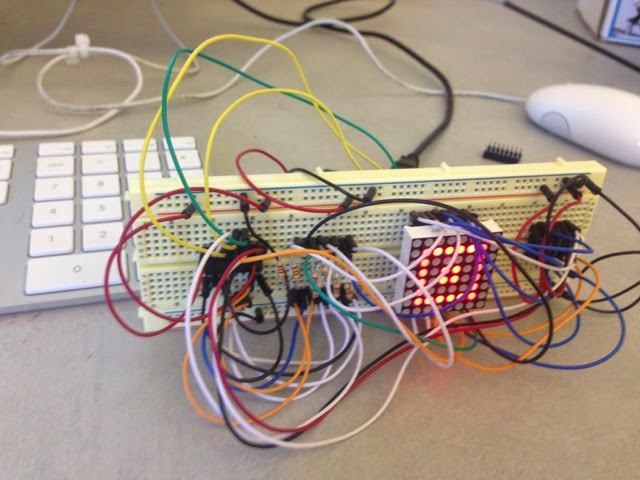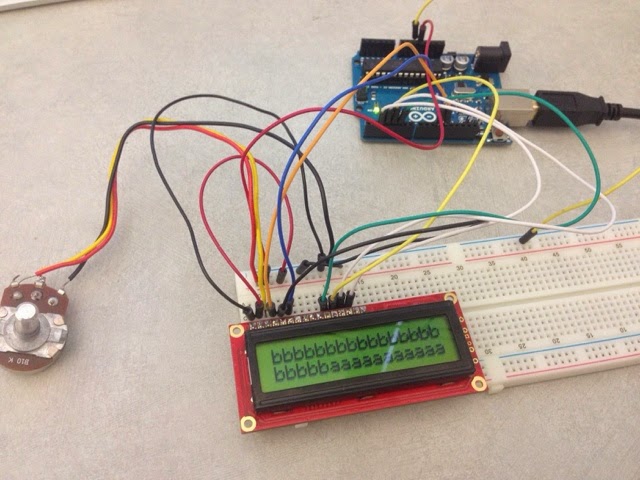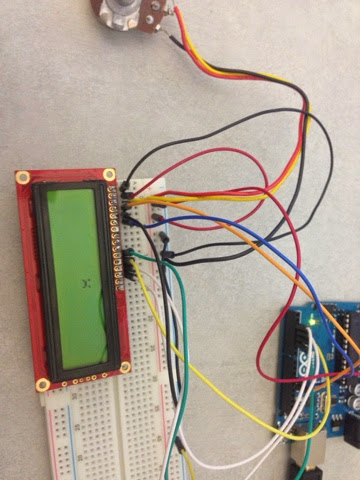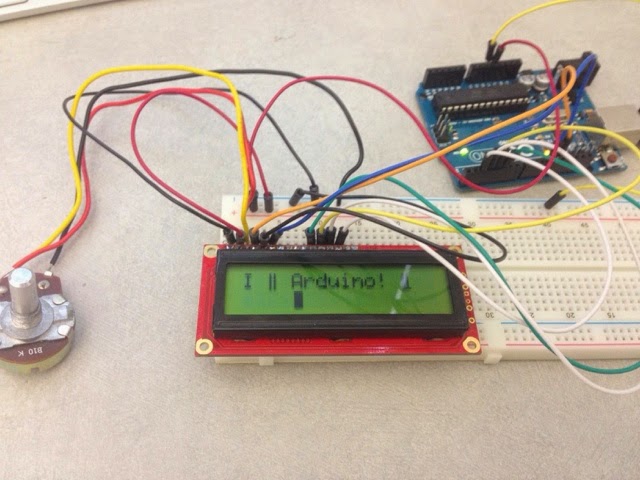Friday, October 31, 2014
Wednesday, October 29, 2014
All Manga Questions, Ch 2 Pr 4, Ch3 Pr Mood lamp, 5, 6, Solder evidence/waveshield, url for adafruit 0-3
2. Contrast the speed of an electron with the speed of electrical motion in one sentence.
electrons that flow through a current are moving fast, yet the electric current is actually a slow flow.
3. Briefly explain the relationship between resistance and energy. Use an example from your house.
The power supply of a particular object makes the current flow while resistors hinder this flow. Some appliances use electric resistance. Appliances that heat up use resistance to do so. As the energy flows through the resistors they "hold" onto the energy and thus the metal will get hot as the resistance grows higher and the friction of the electrons grows higher.
4. What is the difference in AC and DC current? Give and example of each from your daily life.
If you get shocked, DC current is also called direct current is when the direction and the size of the current is fixed. A DC power supply is a battery. AC or Alternating Current is when the current flow is alternating cyclically with time. An example of this is a wall outlet.
5. Determine the equivalent resistance of a 6.0 Ω and a 8.0 Ω resistor if …
a. … connected in series.
6.0 + 8.0 = 14.0 ohms
b. … connected in parallel.
(6.0 x 8.0) / (6.0 + 8.0) = 3.43 ohms
How many of those appliances can you pug into one outlet without tripping a breaker?
dishwasher, microwave, refrigerator, electric shaver, and ceiling fan.
Dishwasher: 1200W, 110V, 10.9 amps, 1.2kwh
- Average cost: $0.94 per use
Microwave: 750W, 220V, 3.4 amps, 0.75kwh
- Average cost: $0.59 per use
Refrigerator: 727W, 220V, 3.29amps, 0.725kwh
- Average cost: $0.57 per hour, $13.68 for 24 hours
Electric shaver: 1200W, 110V, 10.9amps, 1.2kwh
- Average cost: $0.94 each use
Ceiling Fan: 70W, 120V, 0.583amps, 0.70kwh
- Average cost: $0.05 per hour, $1.20 per day (24 hours)
What is the directional relationship between charge and current?
The directional relationship depends on the magnetic force while being a source of the magnetic field. Current is the rate of charge that goes past a given point. The flow of current it opposite of that of the electron charge.
What is the relationship between heat and electricity?
Heat produced is to calories when food is digested, as heat produced is to joules when electricity flows through an electric resistance.
Why is it warm near an incandescent light bulb?
The principle of light emission in light bulbs is paired with thermal emission. The temperature of a substance increases and thermal energy is emitted as electromagnetic waves and as the temperature rises, visible light is emitted.
What is a superconductor? What are they used for in real life? You may have to look this up. How could one make a metal a superconductor?
A superconductor is a material that, when the temperature drops near absolute zero, the atoms reach a state of rest. At this point, electrons are able to move freely without colliding with the atoms, and there is no resistance at all. In real life they're used for things with crazy high magnetic fields, like MRI's and Maglev trains.
To make a metal superconductor, somehow bring aluminum to near absolute zero.
What is Ampere's Law?
When current flows in an electric wire, a magnetic field with a circular pattern is generated around that wire. The magnitude of this magnetic field varies according to the strength of the current. If the direction of the current changes, the direction of the magnetic field also changes.
If current of the same size flows in the same direction in two electric wires placed side by side, what happens?
A magnetic field for twice the current is generated.
What happens if current of the same size flows in opposite directions in two electric wires placed side by side?
The two magnetic fields negate each other.
What is an example of a semiconductor device?
Silicon
Why is silicon used in the manufacture of semiconductors?
The valence electrons are all closely together so when another electron moves through it, it is very difficult. Thus is something with 5 valence electrons come through there is a free electron increasing conductivity
Discuss the difference using an example of the difference between and N-type and P-type semiconductor.
A N-Type semiconductor because the electron which has a negative electrical property, becomes a carrier of electricity. While a P-Type semiconductor because it has a hold which has a positive electrical property, becomes a carrier of electricity.
In your own words describe what a diode does and the role of N and P type semiconductors.
A diode only lets current flow in one direction and in order to form this diode a N-Type and a P-Type must be combined.
What is rectification?
This allows current to flow in only one direction.
What causes color in an LED? Give and example of what causes a particular color.
Because the wavelength of the light emitted depends on the raw material of the semiconductor, various colors of light are created. There are certain crystals that are used to make various colors.
What is the relationship between base current and collector current in a transistor?
A base current is the current that flows down the base to the emitter and the collector current is the current that flows from the collector to the emitter. The collector will change significantly even with a small change in base.
What are the advantages of a transistor over a switch?
It doesn't have physical contact so it doesn't fail.
electrons that flow through a current are moving fast, yet the electric current is actually a slow flow.
3. Briefly explain the relationship between resistance and energy. Use an example from your house.
The power supply of a particular object makes the current flow while resistors hinder this flow. Some appliances use electric resistance. Appliances that heat up use resistance to do so. As the energy flows through the resistors they "hold" onto the energy and thus the metal will get hot as the resistance grows higher and the friction of the electrons grows higher.
4. What is the difference in AC and DC current? Give and example of each from your daily life.
If you get shocked, DC current is also called direct current is when the direction and the size of the current is fixed. A DC power supply is a battery. AC or Alternating Current is when the current flow is alternating cyclically with time. An example of this is a wall outlet.
5. Determine the equivalent resistance of a 6.0 Ω and a 8.0 Ω resistor if …
a. … connected in series.
6.0 + 8.0 = 14.0 ohms
b. … connected in parallel.
(6.0 x 8.0) / (6.0 + 8.0) = 3.43 ohms
How many of those appliances can you pug into one outlet without tripping a breaker?
dishwasher, microwave, refrigerator, electric shaver, and ceiling fan.
Dishwasher: 1200W, 110V, 10.9 amps, 1.2kwh
- Average cost: $0.94 per use
Microwave: 750W, 220V, 3.4 amps, 0.75kwh
- Average cost: $0.59 per use
Refrigerator: 727W, 220V, 3.29amps, 0.725kwh
- Average cost: $0.57 per hour, $13.68 for 24 hours
Electric shaver: 1200W, 110V, 10.9amps, 1.2kwh
- Average cost: $0.94 each use
Ceiling Fan: 70W, 120V, 0.583amps, 0.70kwh
- Average cost: $0.05 per hour, $1.20 per day (24 hours)
What is the directional relationship between charge and current?
The directional relationship depends on the magnetic force while being a source of the magnetic field. Current is the rate of charge that goes past a given point. The flow of current it opposite of that of the electron charge.
Heat produced is to calories when food is digested, as heat produced is to joules when electricity flows through an electric resistance.
Why is it warm near an incandescent light bulb?
The principle of light emission in light bulbs is paired with thermal emission. The temperature of a substance increases and thermal energy is emitted as electromagnetic waves and as the temperature rises, visible light is emitted.
What is a superconductor? What are they used for in real life? You may have to look this up. How could one make a metal a superconductor?
A superconductor is a material that, when the temperature drops near absolute zero, the atoms reach a state of rest. At this point, electrons are able to move freely without colliding with the atoms, and there is no resistance at all. In real life they're used for things with crazy high magnetic fields, like MRI's and Maglev trains.
To make a metal superconductor, somehow bring aluminum to near absolute zero.
What is Ampere's Law?
When current flows in an electric wire, a magnetic field with a circular pattern is generated around that wire. The magnitude of this magnetic field varies according to the strength of the current. If the direction of the current changes, the direction of the magnetic field also changes.
If current of the same size flows in the same direction in two electric wires placed side by side, what happens?
A magnetic field for twice the current is generated.
What happens if current of the same size flows in opposite directions in two electric wires placed side by side?
The two magnetic fields negate each other.
What is an example of a semiconductor device?
Silicon
Why is silicon used in the manufacture of semiconductors?
The valence electrons are all closely together so when another electron moves through it, it is very difficult. Thus is something with 5 valence electrons come through there is a free electron increasing conductivity
Discuss the difference using an example of the difference between and N-type and P-type semiconductor.
A N-Type semiconductor because the electron which has a negative electrical property, becomes a carrier of electricity. While a P-Type semiconductor because it has a hold which has a positive electrical property, becomes a carrier of electricity.
In your own words describe what a diode does and the role of N and P type semiconductors.
A diode only lets current flow in one direction and in order to form this diode a N-Type and a P-Type must be combined.
What is rectification?
This allows current to flow in only one direction.
What causes color in an LED? Give and example of what causes a particular color.
Because the wavelength of the light emitted depends on the raw material of the semiconductor, various colors of light are created. There are certain crystals that are used to make various colors.
What is the relationship between base current and collector current in a transistor?
A base current is the current that flows down the base to the emitter and the collector current is the current that flows from the collector to the emitter. The collector will change significantly even with a small change in base.
What are the advantages of a transistor over a switch?
It doesn't have physical contact so it doesn't fail.
Process 1.9
http://blog.whatgeek.com.pt/2014/08/24/arduino-led-ambient-mood-light-with-lightluminositylux-sensor/
http://arduino.cc/en/Tutorial/Fade
-Add sensor to this and then set up the "fadeAmout" to be what the proximity sensor reads it
- Might have to mess with the number the sensor gives.
http://arduino.cc/en/Tutorial/Fade
-Add sensor to this and then set up the "fadeAmout" to be what the proximity sensor reads it
- Might have to mess with the number the sensor gives.
Sunday, October 26, 2014
Process 1.8
Trials after mid-process crit and research
Trying out Claire's example from her mid-process crit
http://www.taezoo.com/xe/6441
and also this example
http://makezine.com/projects/hotcold-leds/
code: https://github.com/Make-Magazine/HotCold-LEDs
Trying out Claire's example from her mid-process crit
http://www.taezoo.com/xe/6441
and also this example
http://makezine.com/projects/hotcold-leds/
code: https://github.com/Make-Magazine/HotCold-LEDs
Process 1.7
Trials from before mid-process crit
Messing with the parking sensor code and LED configurations:
Messing with the parking sensor code and LED configurations:
Wednesday, October 22, 2014
Process for Project: Finding Code
Does Not Work:
http://www.danielandrade.net/2011/04/09/arduino-sound-sensor/
/*
This is the code to make a LED blink with the music.
You have to set the threshold so it' sensible enough to make the led blink.
You connect an LED to PIN13 and the Sound Sensor to Analog Pin 0
*/
int led = 13;
int threshold = 500; //Change This
int volume;
void setup() {
Serial.begin(9600); // For debugging
pinMode(led, OUTPUT);
}
void loop() {
volume = analogRead(A0); // Reads the value from the Analog PIN A0
/*
//Debug mode
Serial.println(volume);
delay(100);
*/
if(volume>=threshold){
digitalWrite(led, HIGH); //Turn ON Led
}
else{
digitalWrite(led, LOW); // Turn OFF Led
}
}
Works, but doesn’t change when threshold is adjusted
https://www.inkling.com/read/arduino-cookbook-michael-margolis-2nd/chapter-6/recipe-6-7
/*
microphone sketch
SparkFun breakout board for Electret Microphone is connected to analog pin 0
*/
const int ledPin = 13; //the code will flash the LED in pin 13
const int middleValue = 512; //the middle of the range of analog values
const int numberOfSamples = 128; //how many readings will be taken each time
int sample; //the value read from microphone each time
long signal; //the reading once you have removed DC offset
long averageReading; //the average of that loop of readings
long runningAverage=0; //the running average of calculated values
const int averagedOver= 16; //how quickly new values affect running average
//bigger numbers mean slower
const int threshold=400; //at what level the light turns on
void setup() {
pinMode(ledPin, OUTPUT);
Serial.begin(9600);
}
void loop() {
long sumOfSquares = 0;
for (int i=0; i<numberOfSamples; i++) { //take many readings and average them
sample = analogRead(0); //take a reading
signal = (sample - middleValue); //work out its offset from the center
signal *= signal; //square it to make all values positive
sumOfSquares += signal; //add to the total
}
averageReading = sumOfSquares/numberOfSamples; //calculate running average
runningAverage=(((averagedOver-1)*runningAverage)+averageReading)/averagedOver;
if (runningAverage>threshold){ //is average more than the threshold ?
digitalWrite(ledPin, HIGH); //if it is turn on the LED
}else{
digitalWrite(ledPin, LOW); //if it isn't turn the LED off
}
Serial.println(runningAverage); //print the value so you can check it
}
THIS ONE SEEMS TO WORK!!!!!!!
http://arduino-info.wikispaces.com/Brick-SoundSensor
/* YourDuino Electronic Brick Test
Sound Sensor
terry@yourduino.com */
/*-----( Declare Constants / Pin Numbers )-----*/
#define SOUND_PIN A2
#define LED_PIN 13
/*-----( Declare Variables )-----*/
int SoundValue =0;
void setup() /*----( SETUP: RUNS ONCE )----*/
{
pinMode(LED_PIN, OUTPUT); // declare the ledPin as an OUTPUT
Serial.begin(9600); // initialize serial communication with computer
}/*--(end setup )---*/
void loop() /*----( LOOP: RUNS CONSTANTLY )----*/
{
SoundValue = analogRead(SOUND_PIN); // read the value from the sensor
Serial.println(SoundValue, DEC); // send it to the computer (as ASCII digits)
if (SoundValue > 550)
{
digitalWrite(LED_PIN, HIGH); // turn the ledPin on
delay(SoundValue*5); // stop the program for some time
}
digitalWrite(LED_PIN, LOW); // turn the ledPin off
delay(200); // stop the program for some time
}/* --(end main loop )-- */
/* ( THE END ) */
Monday, October 20, 2014
Skycraft Scavenger Hunt
So I actually went back to Skycraft this weekend with my little sister, grandmother, and mom! They seemed to be really impressed by it and had a great time exploring. I think my 11 year old sister was inspired and wants to try some electronics stuff so I'm excited to bring home my Arduino and show her some things next time I visit my family. I got some perf board and more acrylic crystals for my project so expect a post about that tonight, too. :)
Here's the Scavenger Hunt documentation, enjoy..
1. LEDs
2. Capacitors
3. Solar Panels
4. Breadboard
Seen in use with an arduino like ours! Couldn't find any separate breadboards so this will have to do.
5. Devices that contain sensors
6. Cablesss
7. Remote
8. Electronics Kit
9. Perf Board
10. Motors
11. Cameras
...oops forgot to get some of these.
12. Produces a sound intentionally
13. Strobe light
14. Potentiometers
15. Switches
16. Speakers
17. Cases for projects to be built in
18. Magnets
19. Counting display
20. Lcd display
21. Interesting stuff
Here's the Scavenger Hunt documentation, enjoy..
1. LEDs
2. Capacitors
3. Solar Panels
4. Breadboard
Seen in use with an arduino like ours! Couldn't find any separate breadboards so this will have to do.
5. Devices that contain sensors
6. Cablesss
7. Remote
8. Electronics Kit
9. Perf Board
11. Cameras
...oops forgot to get some of these.
12. Produces a sound intentionally
13. Strobe light
15. Switches
16. Speakers
17. Cases for projects to be built in
18. Magnets
19. Counting display
20. Lcd display
21. Interesting stuff
Subscribe to:
Posts (Atom)





















































































